| ..... |

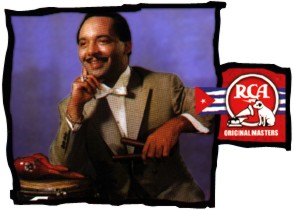
The
Buena Vista Social Club CDs owe a large part
of their success to a revival of Cuban dance music from the 1930-50s, especially
with the Ibrahim Ferrer and Omara Portuondo releases. BMG Records is now
making the real deal available with remastered recordings of the most influential
of the classic Cuban artists with its Cuban Original series.
The series runs the gambit of hard mambo to romantic
bolero styles, and of well-known personalities like Desi Arnaz and Perez
Prado to lesser-known luminaries like Ernesto Lecuono. All but the oldest
recordings have a clean, vibrant sound, thanks to the remastering, though
in some instances where original 78 rpm records were the only source for
rare recordings, the results are decidely lo-fi. The quality of the material
more than compensates, however.
The only disappointment with the Cuban Originals
series is the lack of decent liner notes. Only about half of the discs contain
biographical information on the artists, and none include dates and details
on the tracks.
Listed below is a quick overview of the CDs in
this series I've had a chance to hear so far, plus links to RealAudio sound
samples and purchase information via amazon.com.
|
| |

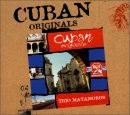
Trio Matamoros
Purchase
info
and RealAudio samples |

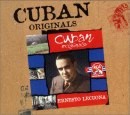
Ernesto Lucuona
Purchase
info
and RealAudio samples |
| |
Trio Matamoros
Few Cuban recording artists in the last 70 years have left us
music as enduringly beautiful as Trio Matamoros. Beginning in the 1920s,
Miguel Matamoros, Siro Rodriguez, and Rafael Cueto first envisioned the
popular form of the Cuban son by updating the older European bolero
style--bearing down on the rhythm and adding melodic texture to the vocals.
"El Que Siembre Su Maiz," one of the trio's early recordings,
marries gentle harmonies to the shimmering pulse of a tres guitar.
But the lulling mood is short-lived as call-and-response vocals take wing
and soar above the intensified beat. "Alma de Roca" has glowing
acoustic guitar textures that most modern musicians could only match with
a bevy of electronic boxes, though this remarkable performance was pulled
straight from an old 78 rpm record. In later years, the trio expanded to
a larger ensemble and added legendary vocalist Beny More, who eventually
became Perez Prado's lead singer before starting his own orchestra. Songs
from the mambo period remain incredibly inventive, from the cascading piano
punctuating "Pelota" to the laughing trumpet of "Buche y
Plume No Mas." Trio Matamoros recorded for almost 50 years, so here's
hoping that the Cuban Originals series has more superb performances
on tap.
Ernesto Lucuona
The man who composed the classic songs "Malaguena"
and "Aragon" is a link between the Spanish melodic tradition of
the late 19th century and the Cuban dance music that would take root around
the 1920s. Cuban-born Ernesto Lecuono straddled both worlds with the virtuoso
piano pieces here--some in a classical music mold, others in salon style--and
his later career as the leader of a popular dance band. No less a figure
than Maurice Ravel praised Lecuona's pianist artistry during his 1924 concert
tour of Spain. His melding of "serious" music with folk dance
rhythms on pieces like "Andalucia" still holds sway today, as
pianists like Buena Vista Social Club's Ruben Gonzales or the Afro-Cuban
All Stars' Guillermo Gonzalez frequently flavor their far-ranging solos
with classical music references. Lecuona's highly emotional performances
on this Cuban Originals disc of songs remastered from old 78 rpm
recordings are jewels of economy, carrying a brooding quality that hangs
in the air long after each song ends. |
| |
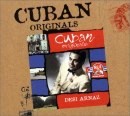
Desi Arnaz
Purchase
info
and RealAudio samples |
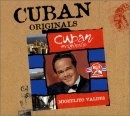
Miguelito Valdes
Purchase
info
and RealAudio samples |
| |
Desi Arnaz
Though Desi Arnaz earned enduring fame as Lucille Ball's television
and real life husband, he was already a star a full decade before "I
Love Lucy" hit the tube. Born in the roots music mecca of Santiago
de Cuba, Arnaz came to America early in life and apprenticed with Xavier
Cugat's orchestra before setting out on his own. He hit his peak in the
post-World War II years. Between 1946 and 1949, Arnaz broadcast radio shows
twice a week, starred in three films with his band, and recorded 43 sides
for RCA Victor. All of the songs on this disc are from that fertile period.
Every cut is loaded with personality, from his signature song "Cuban
Pete" which paints him as an archetypal romantic rogue, to the Latin
calypso, "You Can in Yucatan." But Desi knew mere personality
had its limits and that his voice, however appealing, was thin compared
to the Cuban greats. Thus, he allowed his band ample opportunity to shine
on showcase pieces like the quick-stepping "El Cumbanchero." His
arrangments, though fun, mostly play it safe. Compare his pastoral version
of "Peanut Vendor" to Perez Prado's volcanic trumpet-breathing
mambo or even his "Babalu" with Casino de la Playa's (both featured
on the CD Baile Tropical, also in BMG's Cuban Originals series).
Still, Desi's showmanship constantly shines through, and his huge success
bringing Cuban sounds to the masses guarantees his place in pop music history.
Miguelito Valdes
Forget that he was known as "Mr. Babalu," or that Desi
Arnaz tamed Miguelito Valdes' snarling version of the song for his own stateside
hit. If Valdes isn't the most dramatic of all the classic Cuban vocalists,
he certainly has few contenders. And his disc takes top honors for blatant
entertainment in the 10-volume Cuban Originals series, even if the
material often leans toward show biz fare after a Wayne Newton fashion.
But that's because throughout a long career including stints in Casino de
la Playa and Machito, Valdes seldom shied from any song that would spotlight
his vocal talent. He veers from an Afro-Cuban ritual rumba to an Elvis Presley-style
ballad--all within a single song--in "Echame a Mi la Culpa," dips
into R&B-tinged rock primitivsm in "Linda Mujer," flirts with
the kind of exotic kitsch that made Martin Denny famous in the gradiose
"El Platanal de Bartolo," but mostly plays the barrel-chested
romantic in charismatic ditties like "Angelitos Negros." If at
times it seems that Miguelito Valdes' ambition exceeded his reach, his voice
is so acrobatic you can hardly blame the man from daring anything. |
| |
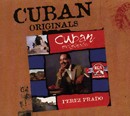
Perez Prado
Purchase
info
and RealAudio samples
|

Conjunto Casino
Purchase
info
and RealAudio samples |
| |
Perez Prado
Perez Prado may not have invented the mambo, but he invented
the style of mambo everyone remembers. The Cuban-born Prado had his first
success developing his high octane variation on the son montuno in
Mexico in 1949. His angular arrangements with chugging rhythms were too
radical for the Cuban recording establishment, but not for the Mexican film
industry. Prado became the musical director sought by leading producers,
and his soundtracks attracted deserved attention back home--leading to a
fruitful collaboration with vocalist Beny More. Many of the songs here bear
the stamp of Prado's cinematic sweep, like "Sabor A Mi" where
a picaresque muted trumpet scales peaks of throbbing brass or the bombastic
annunciation of "Besame Mucho." Because he was so ambitiously
modernist, his ouevre still sounds fresh today. A lightning bug version
of "Flight of the Bumblebee" casts off impressive solos with the
nonchalance of a clown juggling while turning cartwheels. Gaudy and irresistible,
these instrumentals --including two of his earliest mambos--cross-pollinate
Swing Era big band music and Afro-Cuban rhythms with the delicacy of a cymbal
crash. Extra bonus: two songs prefiguring Prado's number one American hit
"Cherry Pink and Apple Blossom White."
Conjunto Casino
Conjunto Casino was a breeding ground for Cuban music legends
including percussionist Carlos "Patato" Valdes, sonero
Roberto Faz, and bandleader/singer Roberto Espi. Propelled by pianist Nico
Cevedo and sweetened with multi-tiered vocals, the band hit its stride in
the 1940s-50s with a potent versatility that was equally at home with roaring
mambos and jazz-influenced takes on the venerable son montuno, like
the bouncy "Que Te Pareve" with the catchiest close-harmony horns
this side of Herb Alpert. Even when playing to the gallery in the novelty-number
"La Vaca Lechera" with trumpet quotes from "Dixie,"
the Conjunto easily acquits itself with strong melodic hooks and a deeply
danceable groove. "Yo Soy Guajiro" shows Espi and company at full-tilt
as Alberto Ruiz launches an urgent lead vocal at a tightly wound chorus
and swirling brass in a wickedly compelling guajira that sounds so
fresh, it might have fallen off the latest Afro Cuban All Stars disc. |
| |
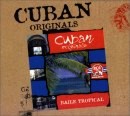
Baile Tropical
Purchase
info
and RealAudio samples |
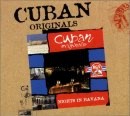
Nights in Havana
Purchase
info
and RealAudio samples |
| |
Baile Tropical
The 1950s were when Cuban music went crazy modern. It was a change
from the status quo as seismic as rock and roll, but in place of primitivism
the bandleaders down Havana way were experimenting with rhythmic complexity,
jazzy playfulness, and orchestral textures you could almost feel on your
tongue. Beny More's band whips up the frothy mambo "Francisco Guayabal,"
Conjunto Casino's "Yo Soy Guajiro" flaunts an out-there piano
solo in the Ruben Gonzales mold, and an explosive timbale breakout jolts
the usually staid Orquesta Aragon on "Sabrosona." Perez Prado's
day-glo mambos are startling enough to warrant three songs from his band,
but Xiomara Alfaro's "Amor de Verano" could melt your CD player's
laser the octave-spanning diva lets loose with yearning that curdles the
soul. An occasional cut, like Enrique Jorrin y su Orquesta's syrupy "Chango,"
may sound a bit dated even in the light of the Buena Vista Social Club's
retro revival, but that isn't necessarily a bad thing. Next to rhythm, Cuban
big band music is all about atmosphere, and this collection is as smoky
and night-scented as they come. Want romantic ballads to accompany these
rumbas and mambos? Check out the sister disc Nights in Havana in
the Cuban Originals series.
Nights in Havana
The decades-long success of peppery Cuban dance music from Kinshasa
to New York City nudged the old fashioned son bolero slow romantic
ballad right off the map. But Wim Wenders' Buena Vista Social Club
documentary film and a "Social Club" CD featuring Ibrahim Ferrer
proved that the old formula of beautiful voice, passionate delivery, and
lush orchestral arrangements still has plenty of kick. The Cuban Originals
series release Nights in Havana goes back to where it all began with
nicely remastered recordings of classic songs from the great ensembles of
the 1950s. Tropical rhythms take a backseat to gliding Swing Era tempoes
and showy brass arrangements, but all is mere ornament to the exquisite
voices on tap. Beny More croons sensuously on "Y Hot Como Ayer"
and two other cuts, while Xiomara Alfaro shows that Yma Sumac wasn't the
only octave hopping Latin songbird of the day. Of all the artists featured
here, Orquesta Aragon is perhaps truest to its roots with lovely charanga-based
based ballads flaunting violins insteads of horns plus silky vocals. Too
much intoxication? Chase it with a hot mambo shot via Baile Tropical
also in the Cuban Originals series. |
| |

Beny Moré
Purchase
info
and RealAudio samples |
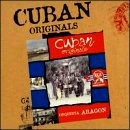
Orquesta Aragon
Purchase
info
and RealAudio samples |
| |
Bene Moré
Aside from being Buena Vista Social Club alumni, what else do
Omara Portuondo and Eliades Ochoa have in common? Their latest releases
both include songs originally made famous by the great Beny More. After
a successful Mexican tour with Conjunto Matamoros, the Cuban vocalist made
his first big splash at the microphone of Perez Prado's supercharged mambo
machine (check out the overheated "Pachito E' Che 1950") before
taking the reins of an orchestra of his own in 1954. Most Cuban singers
are known for their deftness with the romantic bolero or the more aggressive
mambo styles, but More excelled in both areas. On "Y Hot Como Ayer,"
recorded in 1955, he glides from a mid-register croon to effortless trumpet-like
glissandos, his big band pulsating behind him, while he plays a sonero
to a 't' on 1957's "Que Buena Baila Usted," one of many memorable
songs he penned himself. This excellent introduction to More's career includes
newly remastered songs originally released from 1949 to 1958.
Orquesta Aragon
The violin is an instrument few people would associate with Cuban
music. Yet, beginning in the 1940s, Orquesta Aragon made massed fiddles
synonymous with a dance music style called charanga, which added
a dose of urban sophistication to the more pastoral, flute-led danzon
genre. Orquesta Aragon rode a gliding, polished sound based on the interplay
between the string section and the effervescent flute of Richard Egues,
most recently heard backing Senegalese singer Cheik Lo on his breakaway
disc, Bambay Gueej. Though charanga would seem to be at odds with
tougher, more rhythmically charged Cuban dance music, the Orquesta put the
mambo-derived cha cha cha on the map with Egues, composition, "El
Boduguero," which Nat King Cole later took to the top of the American
charts. Famous members of this world class ensemble include Rafael Lay,
who arranged the songs with Egues, and Buena Vista Social Club alumnus
Pio Leiva. The band remains together, but this disc traces the glory days
of the late 1940s to the early 1950s. |
| |
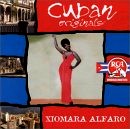
Xiomara Alfaro
Purchase
info
and RealAudio samples |
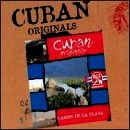
Casino de la Playa
Purchase
info
and RealAudio samples |
| |
Xiomara Alfaro
With her four-octave vocal range, Yma Sumac virtually cornered
the market on exotica back in the 1950s. But that's probably because Cuba's
Xiomara Alfaro was too potent for mainstream American tastes. Instead of
relying on drum-happy Hollywood "tropical" soundtracks to launch
her operatic voice, Alfaro hitched herself to the boleros and mambos of
the day, taking them into uncharted emotional territory with pained ecstacy
only the angels could comprehend. "Luna Rossa" throws off its
Italian roots for Mexican bolero and Cuban sonstylings. "Ochun"
based in part on a traditional religous song to the Orishas
gets the lush nightclub treatment, including a break in which Alfaro imitates
drumming rhythms with her voice. "Siboney" demonstrates that even
a Ernesto Lecuona standard was grist for her repertoire of vocal trills,
swoops, and other tricks. Only on a tough mambo like Ramon Cabrera's "Amor
de Verano" does she complement rather than overwhelm the orchestra,
leaving the ages to contemplate what might have been if she'd teamed up
with Perez Prado's over-the-top ensemble. Instead of a novelty performer,
Alfaro could have made her mark as an audacious modernist.
Casino de la Playa
During its long run at the top, Orquesta Casino de la Playa included
two of the biggest names in Cuban music. In 1945, Anselmo Sacasas left the
band only to be replaced for just one year by Perez Prado, whose bright
horn colors and contrasting instrumental textures gave Havana audiences
a taste of his later audacity with his own orchestra. Though Prado's lasting
influence crackles throughout this disc, center stage belongs to Miguelito
Valdes, one of the most dramatic vocalists in the history of Cuban pop.
Valdes' theme song "Babalu " is here which Desi Arnaz rode
to success in the U.S. along with "Rumba Rumbero," whose
rhythmic flourishes establish the vocalist as one of the earliest recorded
human beatboxes. Perhaps the greatest pleasure of this disc is the Orquesta's
version of Arsenio Rodriguez' "Bruca Manigua," which opens Ibrahim
Ferrer's extraordinary Buena Vista Social Club solo CD. The version here
shows how closely Social Club musical director Juan de Marcos Gonzalez followed
Casino's arrangement on Ferrer's disc. But Valdes' delivery, which adds
tongues of fire to the slow sizzle, runs rings around the remake. |
| |
Other Cuban Originals CDs
Enrique
Jorrin
Cuarteto
D'Aida
I haven't made much headway with these last two titles, due in part to
a lack of information on the artists (which I invite any of you to rectify)
and a lack of enthusiasm over the recordings (which I can't do much about).
Cuarteto D'Aida is a quartet of female vocalists who ply a velvety, harmony-laden
approach that's pleasant enough in small doses but has little of a recognizable
'Cuban' sound. With a little nudge and a steel guitar in the background,
they could just as well be singing South Sea Island fantasy music from the
'50s. Enrique Jorrin musters a smooth vocal presentation reminiscent of
Orquesta Aragon, with nice flute and violin parts. Though miles away from
the ocean of kitsch paddled by Cuarteto D'Aida, the arrangements are still
on the sugary side with a laid-back version of the cha cha cha.
|
| |
Technobeat Central
Cuban Originals write-ups are by Bob Tarte
and copyright 2000 amazon.com and the author. |